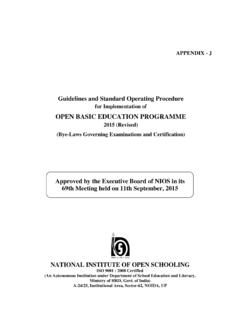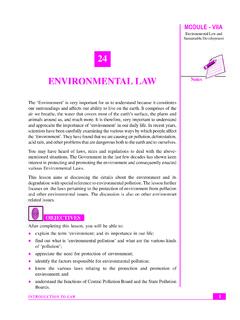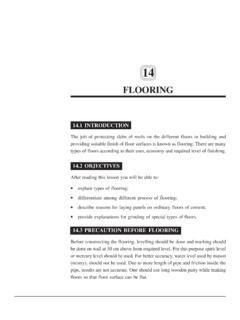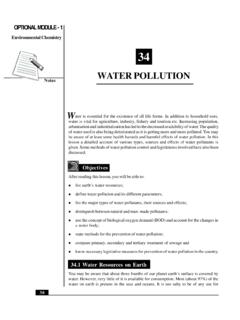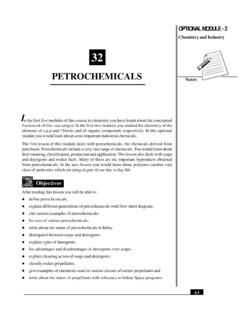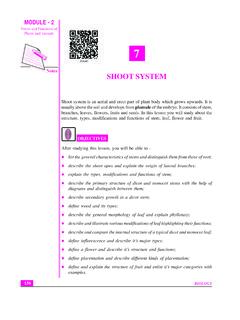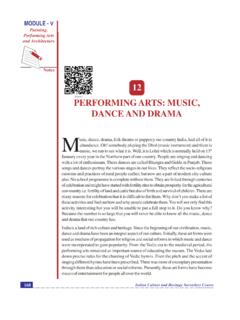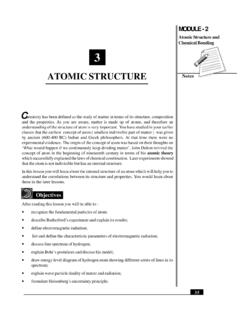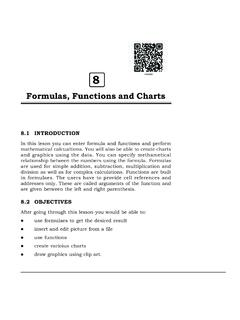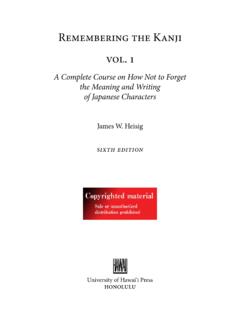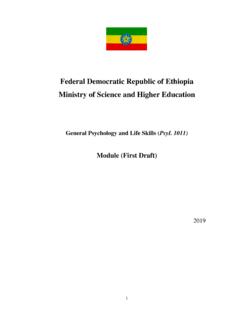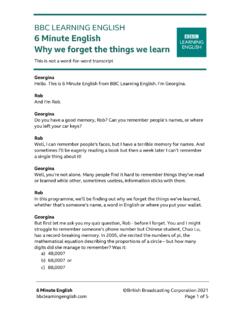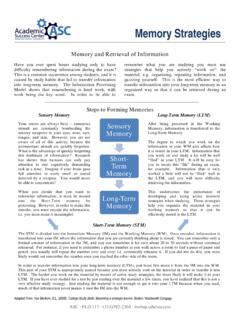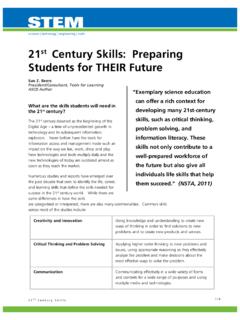Transcription of REMEMBERING AND FORGETTING
1 113 PSYCHOLOGYR emembering and ForgettingNotesMODULE-IIKey Psychological Processes77777 REMEMBERING ANDFORGETTINGDo you remember your first day in the school?On what day did you go to the market last week?Can you name your friends?In our everyday life almost all activities in one or the other way deal with of memory means loss of one s self. Learning will make no sense if it is notretained by the person. It is only through the capacity of memory that we are ableto relate to different events, experiences, conditions, people and objects. Also,we use the understanding thus developed in different contexts and on differentoccasions. Thus, memory makes it possible to operate beyond the constraints oftime and place.
2 A child learns something in class and uses it in the market or athome or some other place. Memory establishes links across diverse s a great mental capacity almost magical. It is needed in developing socialrelationships, mastering cognitive competencies (mental capacities) and solvingvarious problems. There are also occasions when our memory fails and we forgeta name, a formula or fail to recognize a person. The study of memory is one of theoldest fields of research in psychology. Psychologists have been studying variousaspects of memory. In this lesson we will study how our memory works, thefactors which increase or decrease our memory capacity, and what can be doneto improve and ForgettingNotes114 MODULE -IIKey Psychological Processes OBJECTIVESA fter studying this lesson, you will be able to : describe the nature of human memory system; differentiate between short-term memory, long-term memory and the variousways retention is measured; explain the causes of FORGETTING ; describe important aspects of everyday memory; explain the constructive nature of memory; and describe the ways of enhancing memory.
3 SIGNIFICANCE OF MEMORYM emory is a remarkable mental process and a mental system which receivesinformation from (external or internal) stimuli, retains it and makes it available on afuture occasion. It provides continuity to our experiences across different timepoints. A moment s reflection will tell you how difficult it will be if you do not haveintact memory function. You would perhaps loose your identity or the sense ofwhat you are and will always remain a new learner because the past learningexperience will have no value or significance to appears like a tape recorder which records a song or music and playswhenever we demand. Our memory system does perform this but it is more dynamicand versatile than a tape recorder.
4 When some one asks us to sing a particularsong and we sing, then we are working like tape recorders. But human memorydiffers from a tape recorder in many important ways. For instance, we remembernot only verbal material but visual experiences, tactile impressions, feelings of painand joy, motor skills, events, activities and so on. Second, retrieval of informationcan be exactly in the same way or in a different form. Third, the reception of newinformation depends a lot on what information we already have. Fourth, we neitherreceive nor retain all the information presented to us because there is great deal ofselectivity in receiving the information. Fifth, all tape recorders have some limitationon recording but human memory can retain extremely large amounts of , our memory system is an active system.
5 It works on the information may integrate, add, modify, omit or reorganize the information. It is not passivelike a tape recorder which reproduces the information in its original form. KEY ASPECTS OF MEMORYB ased on the features of the human memory system just described, we may saythat memory is a perceptually active mental system. It receives, encodes, modifies,retains and retrieves information. Let us understand these terms more and ForgettingNotesMODULE-IIKey Psychological ProcessesEncoding refers to the translation of incoming stimulus into a unique neural codethat a person s brain can is the retention of the material encoded over a period of is the recovery of the stored or retained information at a later components of memory can be seen in Figure 7.
6 1 : A General Model of Human Memory SystemWe gather information through our senses. Each sensory modality has its ownsensory registor (or sensory memory). It holds information for a very short duration,then it passes the information for further processing to long term memory. Let ustry to understand the three major systems of Memory: Hold a picture in front of you and look at it steadily for awhile. Now close your eyes and notice for how long does a clear image of thatpicture last. A clear visual image of any object will last in our sensory memory forabout a second. Sensory memory occurs within the sensory system while it isbeing transmitted to the we are able to memorize depends to a large extent on what happens to theinformation once it reaches the sensory memory.
7 We are continually bombardedby sensory stimulations of various kinds. As we cannot respond to all of them, itis important that we must selectively focus on those things which are kind of selectivity is possible on the basis of attention. The process of attentionlimits the input of information which we receive from the environemnt. Thus throughselective attention information enters short-term memory (STM). STM holdsinformation for a few seconds and transmits it to the long-term memory (LTM)which has a very large capacity to retain information. INTEXT QUESTIONS the correct is thought to be made up of _____ SensoryinputSensoryregistrar SelectiveattentionShort-TermMemory EncodingRetrievalLong-TermMemory PSYCHOLOGYR emembering and ForgettingNotes116 MODULE -IIKey Psychological Processesb.
8 Twoc. Threed. how long does it usually take for visual information in the sensoryregister to fade?a. about a secondb. from several seconds to a minutec. several minutesd. generally an hour or the memory model, in order for information that has just been sensed toenter short-term memory, it must first SHORT-TERM MEMORY AND LONG-TERM MEMORYWe have read that human memory comprises of three interrelated subsystems,namely - sensory register, short- term memory (STM) and long-term memory(LTM). The sensory register as the name implies makes the environmental input orinformation available for a very short period consisting of milliseconds. The retentionwhich forms the basis for the use of information in future is largely related to thesystems of STM and LTM.
9 Now let s find out what is STM and LTM?The nature and functioning of STM and LTM are different. The distinction may bemade in terms of capacity, duration, type of information retained, and the causesof FORGETTING . These differences are give in and ForgettingNotesMODULE-IIKey Psychological ProcessesShort-term MemoryWhile you are studying, look up for a moment and see around you?What are the thoughts that are occuring to you at this moment?Do you know what you have just done? You have identified the contents of yourShort-term Memory (STM). STM can also be called working memory . Forexample, you look for a telephone number from the diary and after your finishtalking, keep the diary back in your pocket.
10 Looking for and using the telephonenumber is an example of short-term memory. You forget it again after Memory (LTM)Can you remember the name of your childhood friend?Have your ever thought about how you can remember things/events that happenedto you a long time ago. It is possible because of LTM. The sensory memory andSTM are not limited in terms of duration. Information in LTM can last as long aswe live. It is a relatively enduring memory in which information is stored for use ata later 1: Comparison of Short-term Memory (STM) and Long-Term Memory (LTM)FeaturesShort-term MemoryLong-term MemoryCapacityLimited up to 7 items or chunksUnlimitedDurationUsually up to 30 seconds butMay range from daysvaries under different situationsto a life timeType ofVisual images, sounds, words,Meaningful verbalinformationsentencesmaterial, life ofDisplacement of old informationInterference,organizationforg ettingby new one, inadequateof materialIt is clear from Table 1 that while STM has limited capacity and exists for shortdurations, LTM has no known limits.
